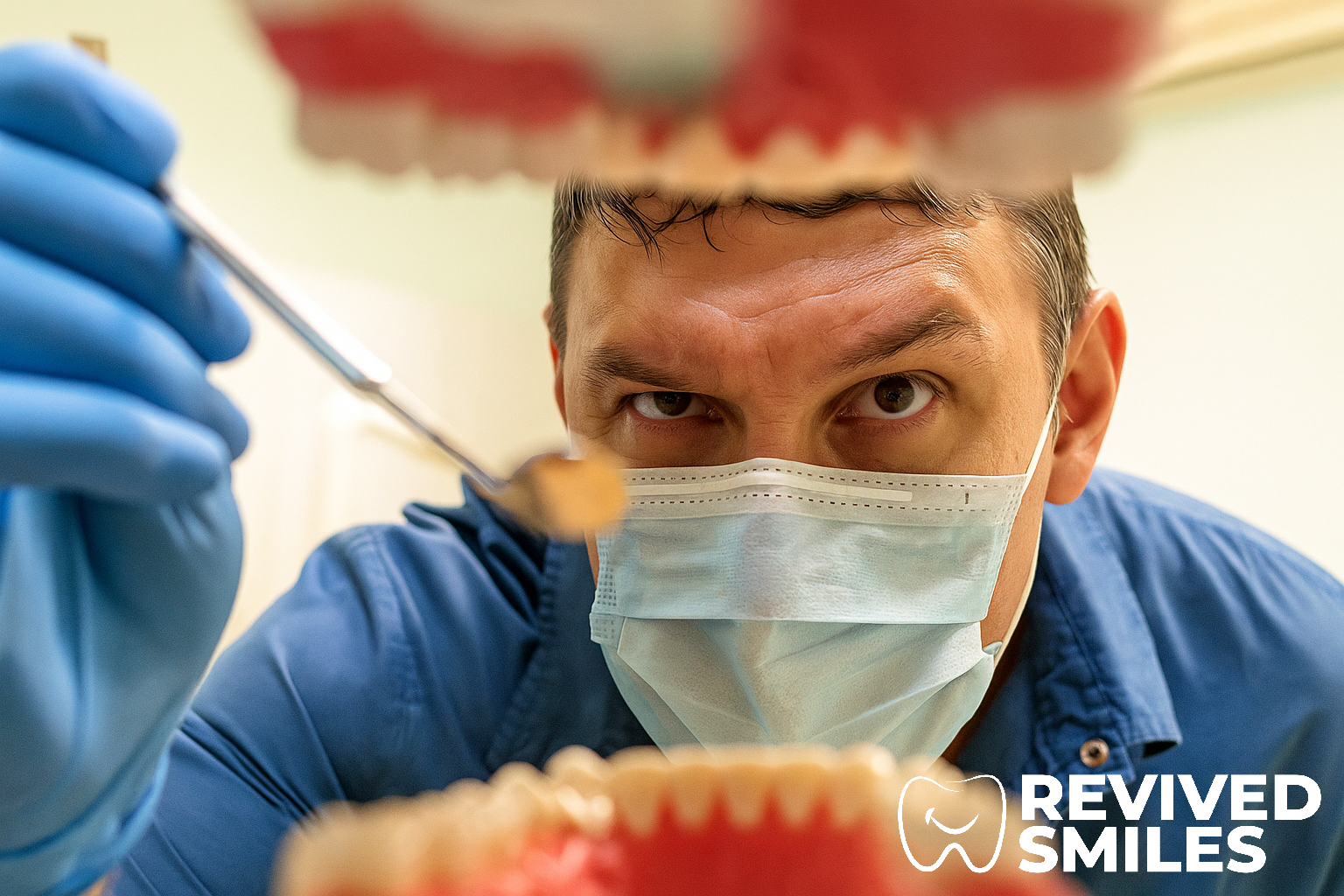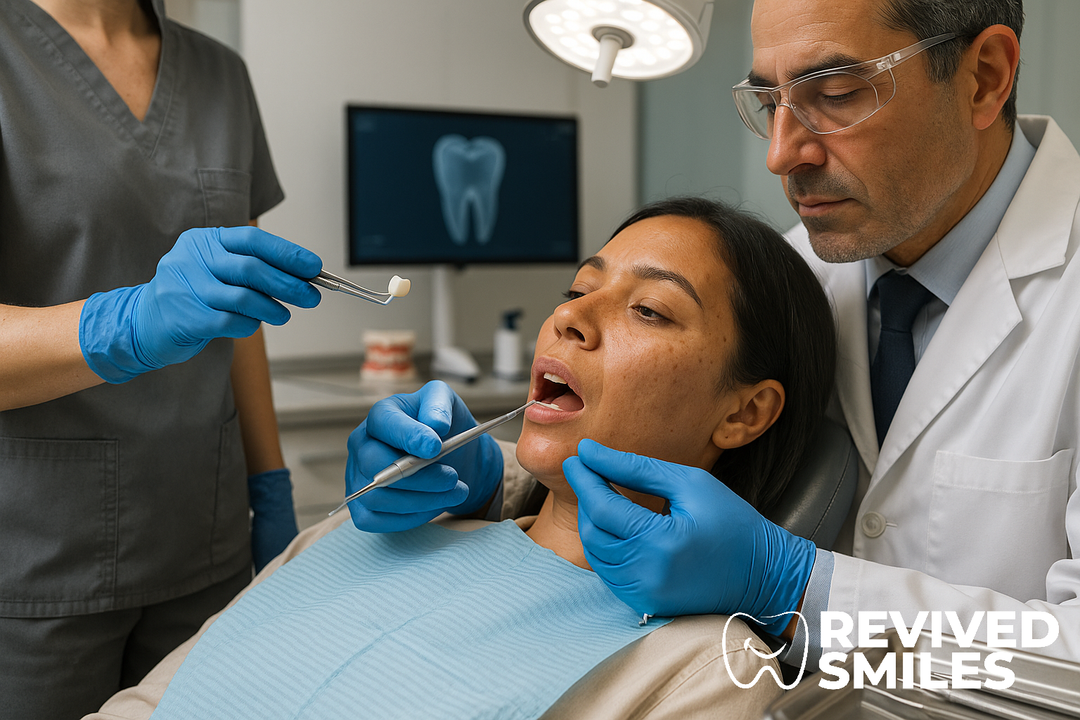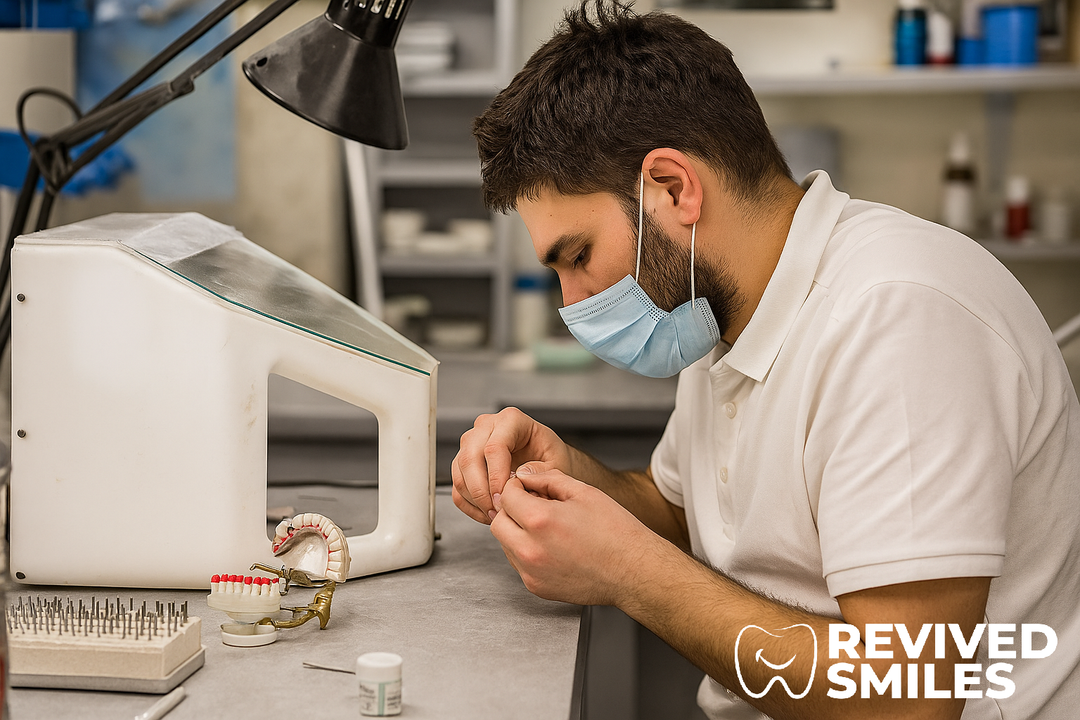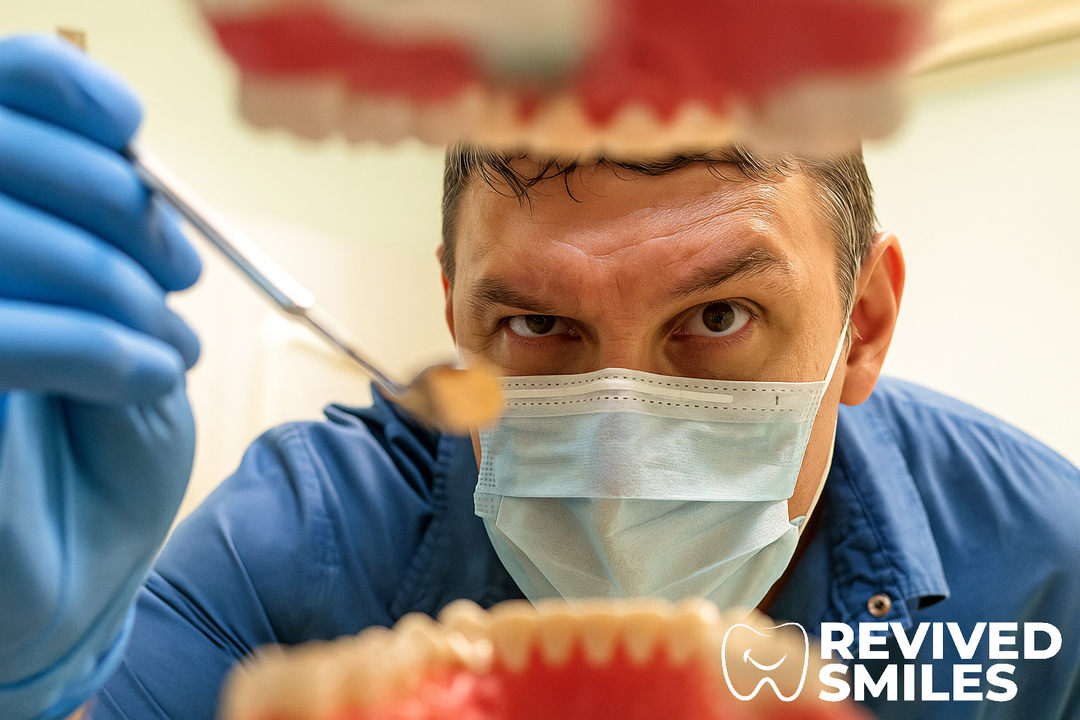Partial Dentures vs Dental Bridges: Which Tooth Replacement Option is Right for You?

Missing teeth can change everything, the way we eat, speak, and smile. It’s not just about aesthetics; it’s about confidence and quality of life. Thankfully, modern dentistry offers effective solutions to restore both form and function.
When it comes to replacing missing teeth, two of the most popular options are partial dentures and dental bridges. In this guide, we’ll explore the key differences between these options, focusing on the bridge vs partial denture comparison to help you decide which is right for your situation.
Revived Smiles will walk you through everything you need to know to make an informed, confident choice.
Understanding the Basics: Tooth Replacement Options
Let’s start with the big picture. A tooth replacement option generally falls into two categories: removable prosthetics, like partial dentures, and fixed prosthetics, like a traditional dental bridge.
Each solution for missing teeth has its strengths and limitations, and the best choice really comes down to your personal needs.
Dentists play a crucial role in evaluating your oral health and helping you choose the most suitable tooth replacement option.
Dental Appliances and False Teeth: The Big Picture
When it comes to replacing missing teeth, dental appliances and false teeth play a crucial role in restoring both the look and function of your smile. Whether you’re missing a single tooth or dealing with multiple missing teeth, there are several tooth replacement options to consider.
Dental bridges are a popular choice for filling gaps left by one or more missing teeth, providing a fixed solution that blends in with your natural teeth. Partial dentures, on the other hand, are removable dental appliances designed to replace several missing teeth, especially when the gaps are spread out across your mouth.
For those seeking a more permanent solution, dental implants offer a way to replace missing teeth with artificial roots anchored directly into the jawbone, supporting either individual crowns, bridges, or even full dentures.
Each of these options comes with its own set of benefits and considerations, so your personal preferences and oral health needs will help determine the best fit for you. No matter which route you choose, the goal is the same: to restore your confidence, comfort, and ability to enjoy life with a complete set of teeth.
What Are Partial Dentures?
Partial dentures are a popular choice when you still have some healthy natural teeth remaining. They are removable dental appliances that replace one or more teeth by anchoring to your existing teeth with small clasps or precision attachments.
Partial dentures typically feature a gum colored base made from acrylic or plastic, which blends seamlessly with your natural gums and provides durability.
They’re designed to replace teeth that are missing in different areas of the mouth, making them functional and, in most cases, quite affordable.
Unlike full dentures, which are used when all teeth are missing, partial dentures are designed to fill in specific gaps without needing to cover the entire dental arch. You can take them out at night or for cleaning, making them convenient for day-to-day use.
Material Options for Partial Dentures
Modern partial dentures come in several material options, each with its own benefits and considerations:
-
Acrylic resin – Lightweight and affordable, making it a common choice for temporary or budget-friendly solutions. However, acrylic can wear faster over time and may require more frequent replacement.
-
Metal frameworks (cobalt-chromium) – Known for their exceptional strength and stability, metal partials are thin, durable, and can last many years with proper care. They offer a secure fit but may be less aesthetic due to visible clasps.
-
Flexible materials (Valplast, TCS, DuraFlex) – Made from high-quality thermoplastic resins, these partial dentures are lightweight, comfortable, and blend seamlessly with your natural gums. They are resistant to breakage, hypoallergenic, and offer a natural-looking appearance without visible metal. Flexible dentures also adapt well to mouth movement, providing enhanced comfort for daily wear.
What Are Dental Bridges?
A dental bridge is a fixed, non-removable option that fills in the gap left by one or more lost teeth. It’s typically anchored by placing crowns on the healthy natural teeth on either side of the gap; these are known as abutment teeth, with a prosthetic or false tooth (pontic) in the middle.
Dental bridges are especially suitable for replacing teeth in a row, such as when several consecutive teeth are missing. They are often chosen to restore teeth (molars) due to their strength and stability.
Dental bridges are great if you’re looking for something that closely resembles your real teeth in both appearance and function. These permanent bridges restore bite strength and blend in seamlessly with your existing smile.
Different Types of Dental Bridges
Your dentist may recommend one of several types of bridges depending on your needs:
-
Traditional bridges are the most common, relying on two crowns on adjacent teeth for support.
-
Cantilever bridges are supported on just one side and are useful when there’s only one neighboring tooth.
-
A Maryland bridge is a less invasive option, often used for front teeth, and features metal or porcelain 'wings' that attach to the back of adjacent teeth.
-
An implant-supported bridge anchors to dental implants instead of natural teeth for added durability.
Cantilever Bridge Options
A cantilever bridge is a specialized type of dental bridge designed for situations where there’s only one healthy tooth next to the gap left by a missing tooth.
Unlike a traditional bridge, which relies on two abutment teeth on either side of the space, a cantilever bridge is anchored to just one adjacent tooth.
This makes it a practical solution when replacing missing teeth at the back of the mouth or in areas where there aren’t two neighboring teeth available for support. The single abutment tooth provides the necessary stability for the false tooth, allowing you to regain function and appearance.
However, because all the pressure is placed on one tooth, cantilever bridges may not be suitable for every case. Your dentist will carefully evaluate your oral health and the position of your missing tooth to determine if a cantilever bridge is the right choice for you.
Implant Supported Options: A Modern Alternative
Implant-supported bridges and dentures represent a significant advancement in modern dentistry for replacing missing teeth. Unlike traditional bridges and partial dentures, which rely on your natural teeth for support, these options are anchored by dental implants that are surgically placed into your jawbone.
This provides a secure and stable foundation for your replacement teeth, making them feel and function much like your natural teeth. Implant-supported bridges are especially beneficial for those with multiple missing teeth, as they help prevent bone loss in the jaw and maintain the natural contours of your face.
These solutions are known for their durability, comfort, and long-lasting results, making them an excellent choice for those seeking a more permanent solution. If you’re considering replacing missing teeth, talk to your dentist about whether implant-supported bridges or dentures could be the right fit for your needs and lifestyle.
Pros and Cons of Partial Dentures

Why You Might Love Them
Partial dentures tend to be more budget-friendly and are usually a non-invasive solution. There’s no reshaping of healthy surrounding teeth required, and they work well when you have several missing teeth in various areas of your mouth. They’re easy to adjust if your oral health changes over time.
Where They Might Fall Short
Because they’re removable, they may shift slightly during meals or conversation. Visible clasps can make them less discreet, especially near front teeth. And they require daily care, which may not suit everyone’s lifestyle.
Pros and Cons of Dental Bridges
The Upside
Dental bridges are stable and feel like your real teeth. Once they’re placed, they stay fixed, no daily removal needed. They can be a great long-term choice for replacing consecutive missing teeth with a solution that doesn’t affect too many other teeth.
Things to Consider
They do come at a higher cost, especially if an implant-supported bridge is needed. Also, placing a traditional fixed bridge often involves reshaping healthy adjacent teeth to fit crowns. If those teeth are in good shape, this may be less ideal.
Comfort and Fit: What to Expect
Comfort and fit are key factors when choosing a dental bridge or partial denture to replace missing teeth. A well-crafted dental appliance should feel natural in your mouth, allowing you to eat, speak, and smile with ease.
Your dentist will take precise measurements and work closely with you to ensure your dental bridge or partial denture matches the shape and color of your natural teeth, providing a seamless look and comfortable fit.
For those with multiple missing teeth, implant-supported options can offer an even more secure and stable fit, reducing the risk of slipping or discomfort. With proper care and regular dental visits, your replacement teeth can continue to feel comfortable and function well for years to come, helping you maintain your oral health and confidence.
Aesthetics and Appearance: How Will Your Smile Look?
The appearance of your dental appliance is just as important as its function. Thanks to advances in modern dentistry, today’s dental bridges and partial dentures are designed to closely mimic the look of your natural teeth, ensuring your smile remains bright and natural-looking.
Your dentist will help you select the right materials and customize the color, shape, and size of your replacement teeth to blend seamlessly with your existing teeth. Whether you’re replacing a single tooth or several teeth, the goal is to create a dental appliance that enhances your natural smile and boosts your confidence.
Implant-supported options can also help maintain the natural shape of your face, preventing the sunken appearance that sometimes follows tooth loss. With the right approach, you can look forward to a beautiful, healthy smile that feels as good as it looks.
Which One is Right for You?
There’s no one-size-fits-all answer. Here’s what to consider:
-
How many teeth are missing? If it’s three or more teeth or scattered across your arch, partial dentures may be more suitable. For fewer teeth in one area, a fixed bridge might be ideal. It’s important to choose a solution that fits the specific gaps left by your missing ones for the best results.
-
What’s the state of your remaining teeth? Weak or decayed teeth might not support a bridge well.
-
Are you dealing with tooth decay, gum disease, or bone loss? These impact how well either solution will work.
-
What’s your budget? Partial dentures generally cost less than a traditional dental bridge or implant-supported bridge.
-
Insurance coverage: Review your insurance coverage to see which procedures are included, as this can significantly affect your out-of-pocket costs over time.
-
Are you okay with dental appliances that are removable, or do you prefer a permanent solution?
Durability and Maintenance
Dental bridges can last 10 to 15 years or longer with proper care. They require brushing, flossing (especially under the false tooth), and regular dental checkups. Porcelain-fused-to-metal bridges offer both strength and a natural look.
Partial dentures usually last 5 to 10 years and may require more frequent adjustments. They're easier to repair or replace if your oral health evolves.
Both bridges and partial dentures benefit from good bone support and healthy gums. Without that foundation, either option may fail to heal properly or feel unstable.
What About the Cost?
The cost of dental bridges and partial dentures can vary widely:
-
Partial dentures can range from $500 to $2,500, with flexible partials on the higher end.
-
A traditional dental bridge might cost $2,000 to $5,000 or more, particularly if it involves implants or spans multiple teeth.
Dental implants used for supporting bridges are generally more expensive but can help preserve the bone structure and gum line after tooth loss.
Let’s Recap: Which One Should You Choose?
If you're seeking a removable, non-invasive, and cost-conscious way to replace missing teeth, partial dentures are an excellent choice, especially when you're missing multiple teeth in different areas.
If you're looking for a permanent bridge that closely mimics real teeth and you have healthy teeth on either side of the gap, then a dental bridge might be your best option. Fixed bridges also work well for consecutive missing teeth and when long-term function is a top priority.
Still unsure? Your best move is to speak with a professional. Consult a dental professional for advice tailored to your oral health, lifestyle, and budget.
You can also explore options like full dentures or other missing teeth solutions to determine the best route for your restorative dentistry needs.
FAQs
What is the difference between a dental bridge and a partial denture?
A dental bridge is fixed in place and not removable, while a partial denture can be taken out. Bridges often feel more like your real teeth.
Is a dental bridge better than a partial denture?
It depends on your needs. If you're replacing one or two teeth and have strong adjacent teeth, a bridge could be better. For multiple missing teeth across different locations, dentures may be more practical.
Which looks more natural?
A porcelain-fused traditional dental bridge typically looks the most natural, especially when replacing front teeth.
How much does a dental bridge cost compared to a partial denture?
Bridges cost more, starting around $2,000. Partial dentures can cost less, sometimes under $1,000.
When should I choose a partial denture over a bridge?
If you’re missing several teeth or your abutment teeth aren’t strong enough to support a bridge, a partial denture is likely the better choice.
Replacing missing teeth is about more than just restoring a smile; it’s about reclaiming your comfort, confidence, and ability to live fully. With the right information and professional guidance, you're already on your way to making the best decision for your health and happiness.





Dejar un comentario